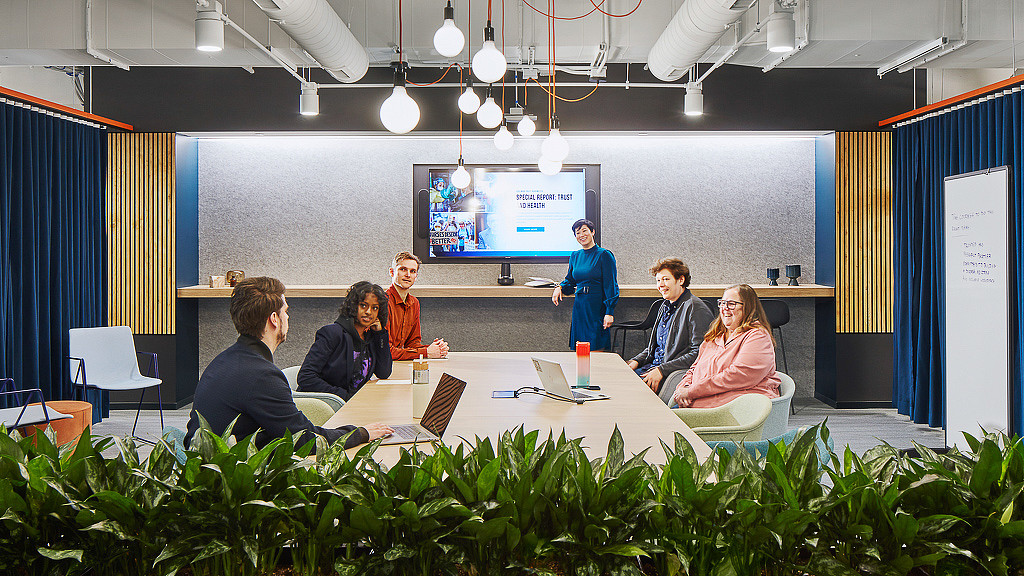Optimizing Hybrid Meetings for Neurodiversity and Inclusion at Work
July 18, 2022 | By Jake deHahn
Hybrid work is here to stay. In this new hybrid world, it’s imperative to make the built environment’s elements equitable for everyone by removing, reducing, and mitigating barriers so all users feel supported in these environments — whether they’re virtual or in person, and regardless of their age, disability, gender identity, race, neurodiversity, socioeconomic status, culture, or workstyle.
As a neurodiverse, deaf designer, I personally rely on and benefit from lipreading and closed captioning/transcription services in our digital world. For an individual such as myself, hybrid meetings are a frustrating pain point when executed without much thought or consideration for the users involved; however, with the right preparation and foresight, hybrid meetings can become a more seamless, inclusive, and effective experience for everyone in your organization.
The pandemic has surfaced a lot of issues and open conversations around diversity and inclusion, which has led to changes to the function of workplaces. The flexibility and safety of working from home, along with the acceleration of technological solutions that make both physical and virtual environments more accessible, has opened doors for the disabled community.
At Gensler, we have teams who specialize in inclusive design guidelines to help clients ensure their spaces go beyond the minimum requirements to be truly as inclusive as possible. As an experience designer, I work on branding, consulting, and digital experience design (DXD) projects to help clients create a sense of belonging in their “new” workplace environments, while bringing elements of digital accessibility and inclusion to ensure all people can experience things equitably.
Here are some inclusive design guidelines for hybrid meetings, based on both my personal experiences and effective tips and strategies I’ve noticed within the disabled community. This list not only helps people with disabilities, but by making hybrid virtual meetings inclusive, it benefits all employees in your organization.
Preparation
- Provide an agenda, task list, or key points that will be discussed in the meeting prior or share during the meeting.
- Not only does this keep everyone in the loop and organized, it also gives people time to digest and prepare in advance if they need the extra time.
- Provide the agenda both verbally for blind or low vision staff, and in written format for those who are d/Deaf or hard of hearing. All people benefit from both methods!
- Consider including an accessibility accommodation statement in your meeting invitation or RSVP form and noting what you will be providing already so people are prepared.
- An example would be: “Please let us know if there are any accessibility accommodations you may need in order to have equitable access. We will have Zoom closed captioning on and the speaker’s presentation deck will be shared after the call.”
- Some tools, like whiteboards, polls, or breakout rooms, are not accessible with assistive devices. Do your due diligence and check or find an accessible alternative.
- Ensure your video call platform allows closed captioning (CC) and that it’s enabled/set up prior to the call.
- Most mainstream video conferencing platforms offer closed captioning with different ways to set up. Take time to make sure it’s available beforehand and work with your IT staff to make access to captioning consistent across your organization.
- There are additional tools that provide full length transcriptions that can be saved for note taking post-calls (like otter.ai). Transcriptions greatly benefit neurodiverse folks who are not always able to take effective notes.
- For larger meetings or conferences, especially ones that are recorded and distributed later, bring in a CART (Communication Access Realtime Translation) transcriptionist and/or a sign language interpreter.
- CART reporters are significantly more accurate than automatic captioning during the meeting and provide a full transcript post-meeting.
- Sign language interpreters should be prominent on the video call screen. Make sure you give enough time to make a plan with your interpreter prior to the meeting regarding any technical needs.
- Check with attendees that need these services if they have any recommendations for an interpreter or CART reporter before seeking a professional. You can find one on resources like the Registry of Interpreters for the Deaf or the National Court Reporters Association.
- In-person, along with a full-room camera, encourage staff to also bring their computers and log into the call with individual cameras on.
- It is difficult to see facial expressions, lip read, and get full context when a room camera makes people’s faces quarter-sized on remote screens.
- Work with your IT team or those who set up conference rooms to have high-quality microphones so in-person staff don’t have to unmute and cause audio feedback.
- Additionally, if using a full-room camera, sit strategically so you do not appear small on your remote staff’s monitors.
- Have the moderator check in with everyone at the beginning of the meeting. For example, “Can everyone on the call see us in the room okay?”
Communication
- Assign a moderator or someone who can facilitate cohesion between virtual staff and those in-office for meetings that are of larger sizes. Usually a project manager, team lead, or supervisor naturally assumes this role.
- This helps reduce awkward interruptions, engages virtual employees, and increases productivity with having a more organized call.
- As the moderator, remember to keep up with the chat function and weave it into the conversation. Create a system that works best for everyone to participate in a way that is comfortable for them.
- Try out inclusive introductions when possible or appropriate.
- This is a verbal description of you and your environment to paint a picture for those who have low vision, are blind, or are joining the meeting from a place where it is unsafe for them to look at their screen.
- It gives an opportunity to share your personal pronouns, any nicknames you go by, or how to pronounce your name. Doing and normalizing this provides a safe space for LGBTQ+ staff, while it also helps foster an appreciation of your diverse culture.
- You can describe yourself in whatever way feels most comfortable for you, and have fun with it! Example: “Hi, I’m Jake. I’m a white male and use he/him pronouns. I’m wearing a yellow button up shirt, blue glasses, and have facial hair. I’m at home with wall maps behind me and a bookshelf with plants on top... that need watering!”
- Avoid using age references, i.e., “I am a 30-something…” unless you are certain that all participants will be comfortable with you disclosing that information.
- When sharing your screen, describe what’s being displayed.
- Instead of saying “As you can see here...” try a brief description like “This pie chart on the slide shows that 71% of the target group...”
- This not only helps the blind or those with low vision, but it also helps people who are listening in and are unable to look at a screen benefit from your verbal descriptions.
- Repeat written or spoken questions or statements before beginning to answer them.
- Do this especially if it’s verbalized by an audience member in person since most microphones won’t catch it or see the person themselves.
Technical suggestions
- Encourage usage of the “Chat” function in calls.
- This helps those who may not physically be able to or are uncomfortable speaking aloud.
- Sometimes it’s difficult to know when there’s a pause in conversation to jump in, so chats give people time to process information and reply at their own pace.
- Beyond disabilities, chats benefit those who are on-the-go or in noisy environments that make it difficult to speak and be understood.
- Virtually, when you unmute yourself before speaking, consider turning your camera on as well.
- This helps those who are d/Deaf or hard of hearing for lipreading.
- Seeing someone’s face provides visual and social cues that aren’t always understood by audio alone, something many neurodiverse individuals struggle with.
- If you are uncomfortable or unable to turn your camera on, that’s okay — just be sure to confirm people can hear you clearly and closed captioning or transcriptions are available.
- Be mindful of lighting: glares, low lighting, or shadows on your face that make it difficult to see your face.
- Try a ring light or repositioning yourself to solve the issue.
- For conference rooms, utilize glass wall privacy screens, lighting solutions, or optimizing layout to improve the lighting for the room.
Wrapping up
- Be clear to indicate that the meeting is over or when you are moving on to something different.
- Those who struggle with social cues will benefit from direct clarity.
- When applicable, share any documents that were shown in the meeting with participants after the meeting.
- Utilize accessibility tools on most media platforms to optimize the file’s accessibility — many have a “Check Accessibility” function in Microsoft Word, PowerPoint, and Adobe Acrobat DC.
- If the meeting was recorded, ensure the video has closed captioning on it or provide a full transcript with the recording.
- Ask for feedback!
- The best way to improve and make your meetings more inclusive is by learning from your teammates and peers. Allowing a safe space for people to communicate their needs is critical to a healthy and inclusive work environment.
Don’t:
- Don’t assume everyone is abled on your team! In fact, the majority of disabilities are not visibly seen — and some people don’t feel comfortable sharing their disability. That’s why it’s vital to take these steps to make your hybrid workplace inclusive. Plus, as an added bonus, you can retain and increase hiring disabled staff (read about the benefits of inclusive hiring here) and begin to cultivate a healthy and positive culture for all.
For media inquiries, email .

